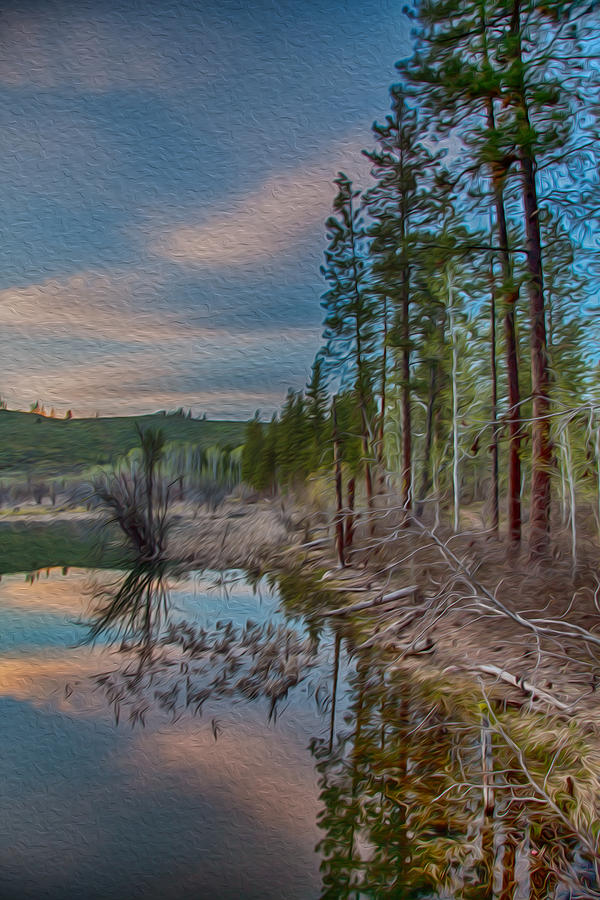
Evening on the Banks of a Beaver Pond

by Omaste Witkowski
Title
Evening on the Banks of a Beaver Pond
Artist
Omaste Witkowski
Medium
Photograph - Digital Photograph
Description
Evening on the Banks of a Beaver Pond
Omaste Witkowski
MotivationalArtwork.com
The wise man does not lay up his own treasures. The more he gives to others, the more he has for his own. ~Lao Tzu
This photograph was taken in Winthrop Wa (Washington State), in the beautiful Methow Valley. Specifically the beaver ponds near Sun Mountain Lodge. Sun Mtn Lodge is a resort located in the Methow Valley, a small jewel of an area not too far from Seattle in the Pacific Northwest. Okanogan County is such a great place to live for all of the sunshine and outdoors recreation.
I started with a digital photograph and used a HDR process to tone map the light. Then I applied a finishing oil paint layer to add texture to the overall image. I did some tonal work to even out the colors and make them realistic to what I was seeing in nature but not excessively.
I am interested in photography as an "unusual" or "unique" image making process. In other words I enjoy starting with a photograph of an ordinary scene or subject and then I try to make it my own by adding unusual processing techniques. I hope you enjoy viewing my work as much as i enjoy creating it.
---------------------
Explore the attractive custom framing and matting options available on this page; all are competitively priced.
If you have any questions about my images or need assistance with sizing, framing, etc., please contact me, before placing your order, at [email protected]
----------
From Wikipedia
"Beaver dams are dams built by beavers as protection against predators such as coyotes, wolves, and bears, and to provide easy access to food during winter. Beavers work at night and are prolific builders, carrying mud and stones with their fore-paws and timber between their teeth. Beavers can rebuild primary dams overnight, though they may not defend secondary dams as vigorously.
Samuel Hearne wrote: "their dams, by frequent repairing, become a solid bank, capable of resisting a great force both of ice and water; and as the willow, poplar and birch generally take root and shoot up, they by degrees form a kind of regular planted hedge, which I have seen in some places so tall that birds have built their nests among the branches."[cit
Disruption
Beaver dams can be disruptive; the flooding can cause extensive property damage, and when the flooding occurs next to a railroad roadbed, it can cause derailments by washing-out the tracks, or when a beaver dam bursts and the resulting flash flood overwhelms a culvert. Traditional solutions to beaver problems have been focused on the trapping and removal of all the beavers in the area. While this is sometimes necessary, it is typically a short-lived solution, as beaver populations have made a remarkable comeback in the United States (after near extirpation in the nineteenth century) and are likely to continually recolonize suitable habitat.[1] Modern solutions include relatively cost-effective and low maintenance flow devices. However, introduced to an area without its natural predators, as in Tierra del Fuego, beavers have flooded thousands of acres of land and are considered a plague. One notable difference in Tierra del Fuego from most of North America is that the trees in Tierra del Fuego cannot be coppiced[citation needed] as can willows, poplars, aspens, and other North American trees. Thus the damage by the beavers seems more severe. The beaver's disruption is not limited to human geography; beavers can destroy nesting habitat for endangered species, and often destroy mature trees for which they have no use.[citation needed]
Benefits
Dam building can be very beneficial in restoring wetlands. Such wetland benefits include flood control downstream, biodiversity (by providing habitat for many rare as well as common species), and water cleansing, both by the breakdown of toxins such as pesticides and the retention of silt by beaver dams. Over the eons, this collection of silt produces the rich bottom land so sought after by farmers. Beaver dams reduce erosion as well as decrease the turbidity that is a limiting factor for much aquatic life. While beavers can create damage, part of the problem is one of perception and time scale. Such damage as the undermining of a roadway or the drowning of some trees is very visible shortly after the beginning of beavers activity in an area. The benefits may be long-term and unnoticed except, for example, by someone monitoring a catchment."
Uploaded
April 27th, 2013
Statistics
Viewed 2,702 Times - Last Visitor from New York, NY on 04/24/2024 at 1:30 AM
Embed
Share
Sales Sheet






































